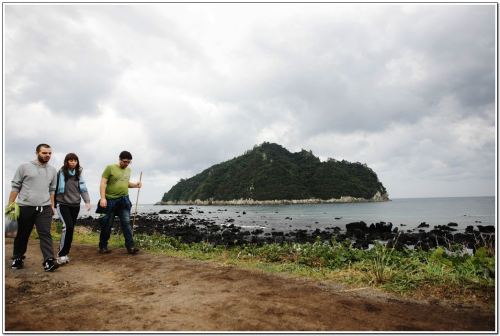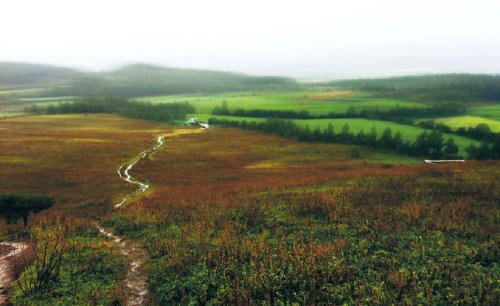 |
The view from the top of Aloreum, located on Jeju Island’s Olle trail route No. 1 (Claire Lee/The Korea Herald) |
A lazybones finds hiking Jeju’s scenic Olle trails awakens the senses
JEJU ― It’s a rainy November day on Jeju Island and the leaves have turned yellow and red.
The top of Aloreum, on Olle trail route No.1, is difficult to make out. Fog drifts over it like mist at the base of a waterfall. One of Olle’s most famous spots, Aloreum is one of Jeju’s many oreums ― volcanic cones that look like small mountains or hills.
The spot is usually filled with visitors determined to enjoy its fabled panoramic view.
But this time, there is only haze and the smell of grass, with a rare sense of tranquility in a serene, almost sacred atmosphere. Around this spot, people are encouraged to be slow and act like a “gansedari,” which means a lazybones in Jeju dialect. You would miss out on a lot by walking too quickly.
Jeju Olle is 250 km of connecting paths that take hikers all along the south coast of the island. Suh Myung-sook, former editor of OhmyNews and founder and president of Jeju Olle Foundation thought of creating the trail routes on Jeju after making her own pilgrimage to Spain’s Camino de Santiago in 2006.
She returned that year to Jeju, where she was born and raised, and set up a team to create trails by restoring old, hidden paths that are not accessible to cars. The paths lead across the island’s unique, volcanic landscape, with exquisite sea shores, oreum, and black stone walls made of Jeju’s signature basalt.
“I think walking is the most humane way of traveling,” Suh had said during an Olle trail event on Jeju the day before. “Being slow and old fashioned in this digital era is more like a quiet revolution.”
As the fog gets heavier, the path becomes muddy and slippery with rain. But there is more than a slippery slope to slow me down. The heavy moisture enhances the scent of mud and tiny little flowers, causing me to stop and take in the air. As I inhale, I hear the beating of my heart, and the pulsing of my blood.
 |
The view from the top of Aloreum, located on Jeju Island’s Olle trail route No. 1 (Claire Lee/The Korea Herald) |
Many travel writers say this is the very charm of walking.
“You get to use all your senses,” celebrated travel writer Han Bi-ya, who calls Aloreum the “most beautiful scenery of the whole universe,” said in a speech on Jeju just the day before.
“You listen, you smell, and you discover. And most of all, you get to discover yourself.”
With the smell of the wet leaves and stones, I forget my initial goal. The hiking is no longer about getting to the top of the oreum, but about rambling as much as you please. It’s hard not to slow down and appreciate the surroundings, in spite of the rain, especially the pastel-colored wild flowers and the vast, all-season green fields complimented by autumn leaves.
I finally reach the top, and I find my shoes have become completely covered with mud. The rain still pours down, and I look ridiculous in my tacky raincoat, but feel rather content, surrounded by the panoramic view of the island. Listening to the rhythmic rattle of rain and the howl of the wind, a warm sense of joy settles on my shoulders and spreads down to my toes. I am alone with the nature, a rare, fascinating moment for a city person.
About six hours prior to the Aloreum visit, I took Jeju Olle route no. 6, which starts at Jeju’s Soesokkak estuary. It is the opening day of 2011 Jeju Olle Walking Festival.
Hikers from Korea and abroad are gathered at the entrance of the trail, wearing Olle-themed green and sky-blue scarves decorated with silly-but-cute badges and charms. We are invited to hike the route No. 6, a 14 km course which cuts through downtown Seogwipo and leads past Cheonjiyeon Falls, and finishes at Oedolgae rock.
As Lonely Planet founder Tony Wheeler, who visited Jeju for the event, said earlier, one of the joys of walking is meeting people. It’s easy to spot locals mingling with groups of tourists, sharing Jeju tangerines and rice wine as they take breaks from walking.
Throughout the course, we run into a series of food vendors and artistic performances prepared by the locals. There is raw fish, roasted rice balls, and rice cakes complimented by Jeju’s tangerine sauce. Almost everyone uses their own chopsticks, which they were told to bring. The idea was introduced by Jeju Olle Foundation, who wanted to make the festival an environmentally-friendly event by reducing the use of disposable products.
When we reach Jjigioreum, a group of local musicians are playing “Oh My Darling, Clementine,” on wind instruments. Everyone enjoys the familiar music, with a tangerine or two in their hands, taking their time before heading to the next step.
“I’ve never thought of coming to Jeju when I first arrived a week ago,” says Jean Walsh, a tourist from the U.S., who spontaneously made her visit to Jeju two days ago. “I walked the trails alone yesterday, and I’m walking with a lot of strangers today. Both have been fun so far, making you appreciate the scenery in different ways.”
Jeju Olle trails have a total of 12 routes along the south coast of Jeju. For more information about the trails, visit www.jejuolle.org or call (064) 762-2190.
By Claire Lee (
dyc@heraldcorp.com)









![[Today’s K-pop] Blackpink’s Jennie, Lisa invited to Coachella as solo acts](http://res.heraldm.com/phpwas/restmb_idxmake.php?idx=644&simg=/content/image/2024/11/21/20241121050099_0.jpg)